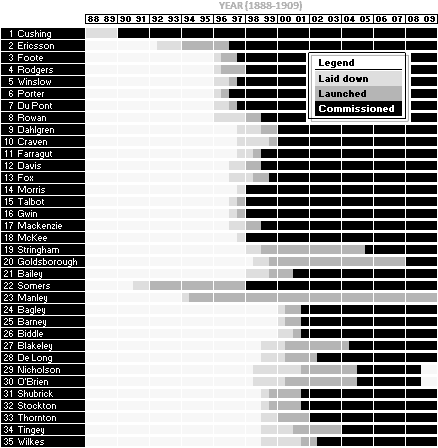Torpedo boats Davis, Rowan, Goldsborough and Farragut at San Diego, ca. 1900. (NH 100039-KN)
Following seven years of development at the
Torpedo Station using
Cushing, the US Navy took delivery of more large and small torpedo boats as follows
1:

- Fiscal year 1891: Ericsson (Torpedo Boat No. 2), a modified Cushing built in Iowa to Navy plans.
- Fiscal year 1895: Foote, Rodgers and Winslow (Torpedo Boats Nos. 3–5), enlarged versions of Ericsson.
- Fiscal year 1896: Herreshoff-designed Porter and Du Pont and Navy-designed Rowan (Torpedo Boats Nos. 6–8).
- Fiscal year 1897: ocean-going 30-knot boats Dahlgren and Craven from Bath Iron Works and Farragut from Union Iron Works; intermediate-size 22.5-knot boats Davis and Fox from Wolf & Zwicker and Morris from Herreshoff; and small 20-knot boats Talbot and Gwin from Herreshoff, Mackenzie from Hillman and McKee from Columbian. (Torpedo Boats Nos. 9–18).
- Fiscal year 1898: Stringham, Goldsborough and Bailey (Torpedo Boats Nos. 19–21).
- Fiscal year 1899: German-built Somers and never-commissioned Manley (Torpedo Boats Nos. 22–23); three Bagley-class, Bagley, Barney and Biddle (Torpedo Boats Nos. 24–26), seven Blakely-class Blakely, DeLong, Shubrick, Stockton, Thornton, Tingey and Wilkes (Torpedo Boats Nos. 27, 28 and 31–35) and two Nicholson-class Nicholson and O’Brien (Torpedo Boats Nos. 29–30).
Ten boats operated in the 17-week Spanish-American War of 1898: Cushing, Ericsson, Foote, Rodgers, Winslow, Porter and Du Pont (Torpedo Boats Nos. 1–7) and the smaller Talbot, Gwin and McKee (Torpedo Boats Nos. 15, 16 and 18). Off Cuba, Winslow received battle damage and casualties in an engagement at Cárdenas Bay on 11 May while Ericsson took part in the 3 July battle off Santiago.
Three torpedo boats saw active service as late as World War I. Others were relegated to auxiliary roles or disposed of prior to that time.

